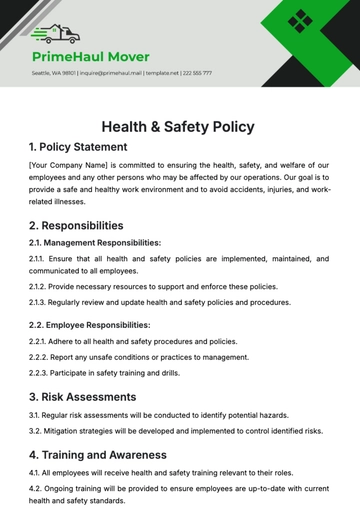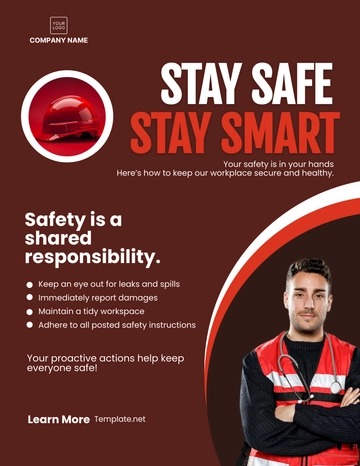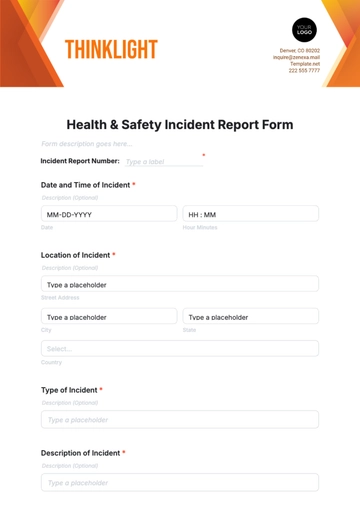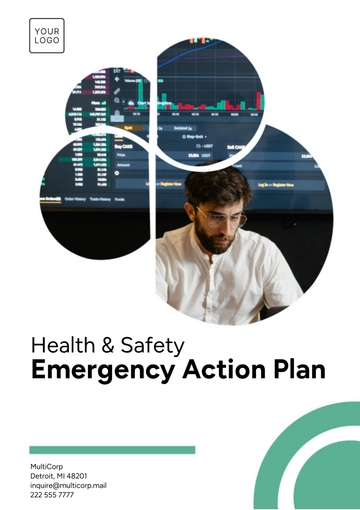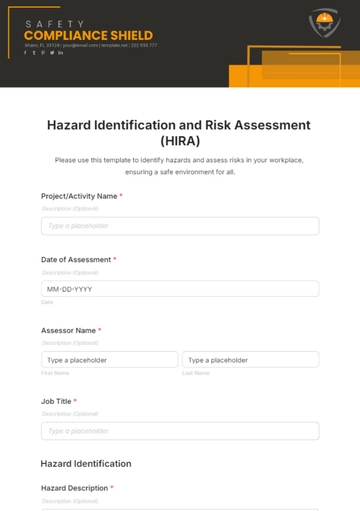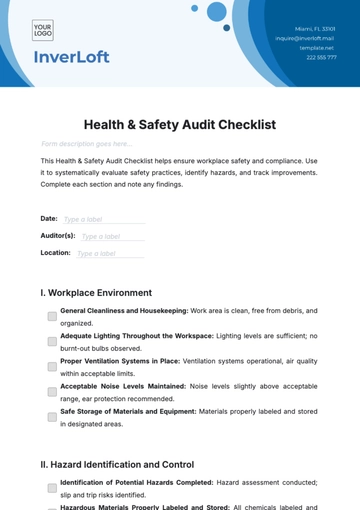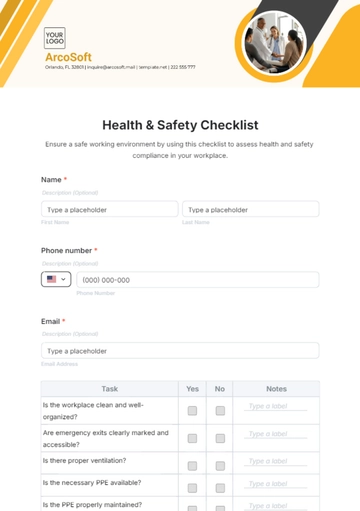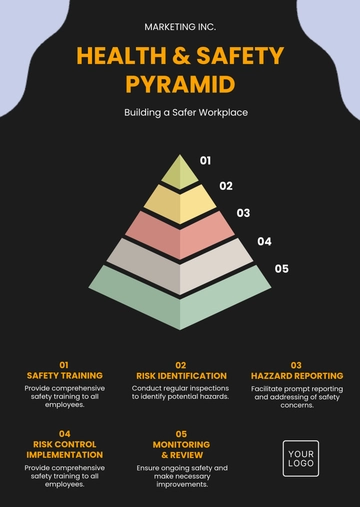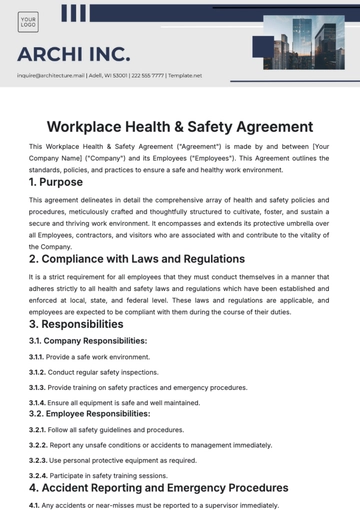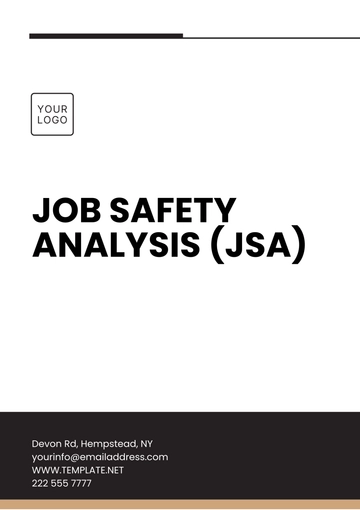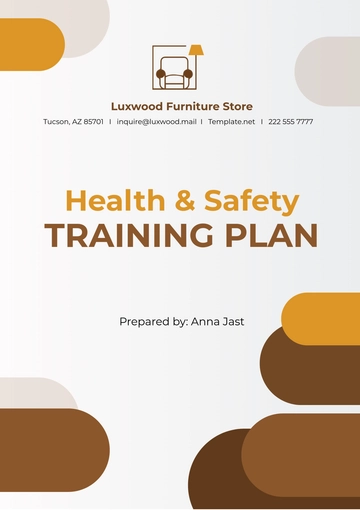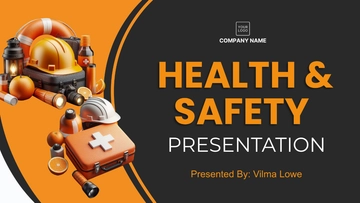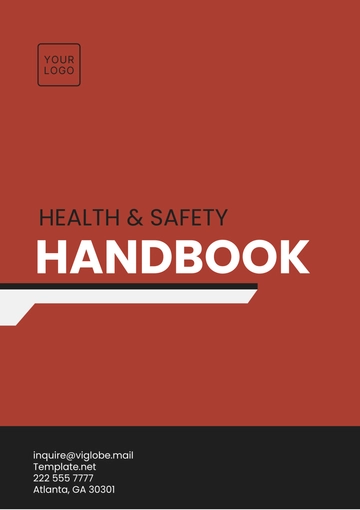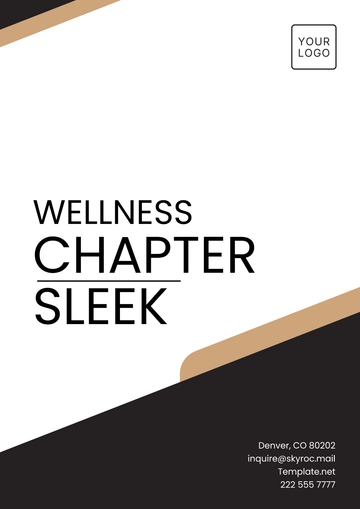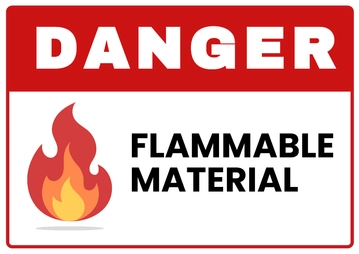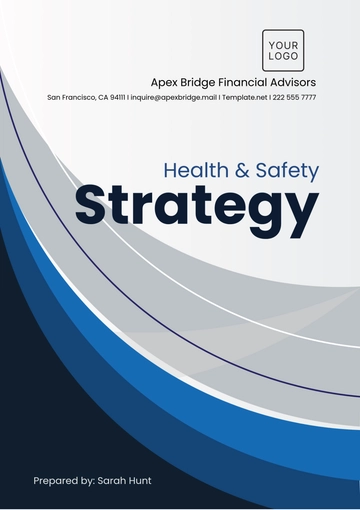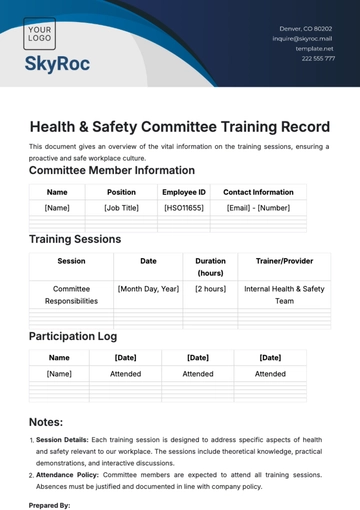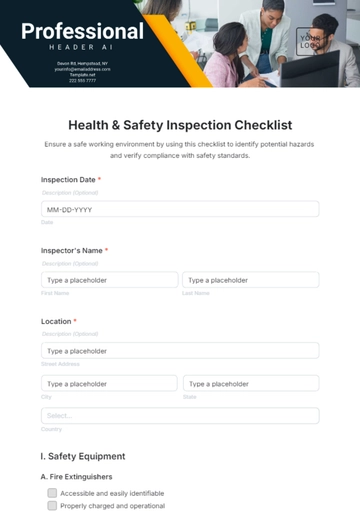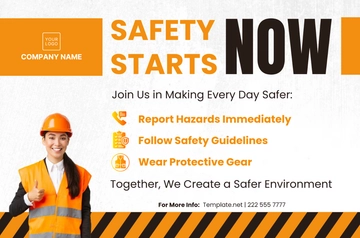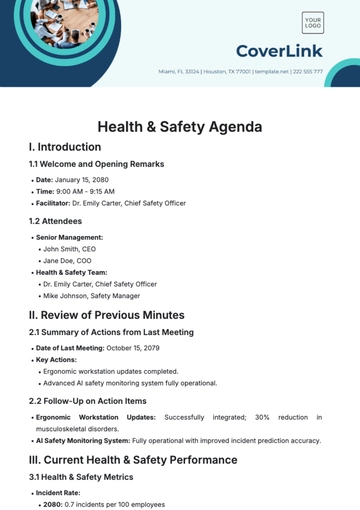Free Nursing Home Food Safety and Sanitation Guide
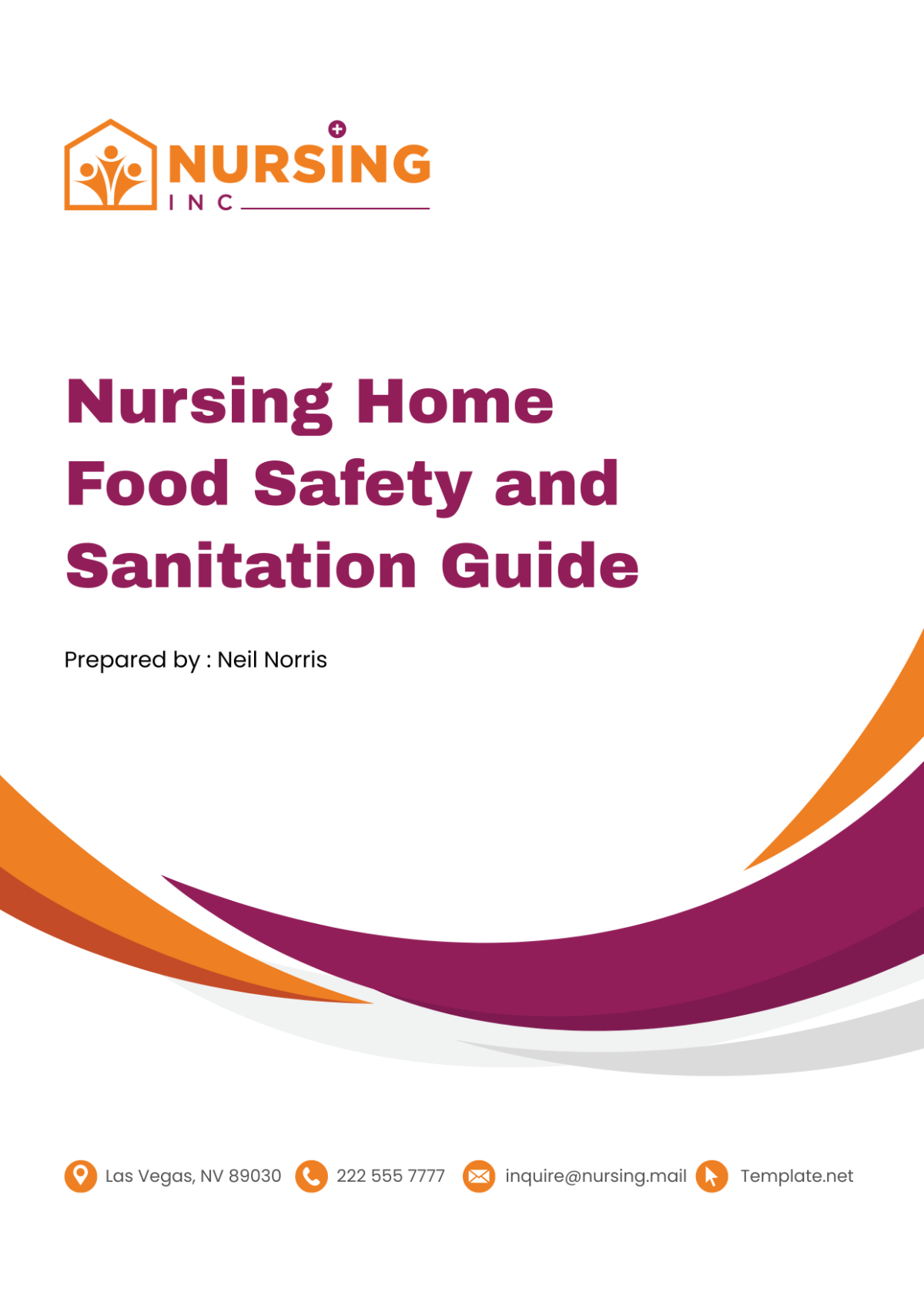
I. Introduction
A. Purpose
The primary purpose of this Nursing Home Food Safety and Sanitation Guide is to establish robust protocols and procedures to ensure the safety and well-being of residents, staff, and visitors at [Your Company Name]'s nursing home facility. By implementing comprehensive food safety and sanitation measures, we aim to prevent foodborne illnesses, maintain regulatory compliance, and uphold the highest standards of hygiene and cleanliness in all food handling areas.
B. Scope
This guide covers every aspect of food handling, storage, preparation, serving, and sanitation within our nursing home premises. It applies to all staff members involved in food-related tasks, including kitchen staff, caregivers, dietary aides, and management personnel. The scope encompasses:
Food storage and handling procedures
Sanitation protocols for kitchen and dining areas
Personal hygiene practices for staff members
Prevention of foodborne illnesses
Staff training and education
Emergency preparedness and response
C. Audience
This guide is designed for the entire staff at our nursing home facility who are directly or indirectly involved in food handling activities. This includes kitchen staff responsible for food preparation, dietary aides involved in serving meals, caregivers assisting residents during meals, and management personnel overseeing food safety protocols. All staff members are expected to adhere to the guidelines outlined in this document to maintain the highest standards of food safety and sanitation.
II. Food Safety Standards
A. Regulatory Compliance
[Your Company Name] is committed to adhering to all relevant local, state, and federal regulations governing food safety and sanitation in nursing home facilities. This includes compliance with guidelines established by regulatory bodies such as the Food and Drug Administration (FDA), the Centers for Disease Control and Prevention (CDC), and the Department of Health.
B. Best Practices
In addition to regulatory requirements, [Your Company Name] follows industry best practices to ensure the safe handling and preparation of food for our residents. These best practices encompass various aspects of food safety, including storage, preparation, cooking, and serving. Below are some key best practices that our staff members are expected to follow:
1. Storage
Proper storage of food items is essential for preventing contamination and spoilage. It involves maintaining appropriate temperature and humidity levels in storage areas, rotating stock regularly to minimize the risk of spoilage, and storing raw and cooked foods separately to prevent cross-contamination.
Best Practice | Description |
|---|---|
Temperature Control | Ensure storage areas are maintained at the appropriate temperature (e.g., below [40°F] for refrigerators, [0°F] for freezers). |
Stock Rotation | Rotate stock regularly to use older items first and prevent expiration or spoilage. |
Segregation | Store raw meats separately from ready-to-eat foods to prevent cross-contamination. |
2. Preparation
Proper preparation of food involves several steps to ensure its safety and quality. This includes thawing frozen foods in designated areas to prevent bacterial growth, washing fruits and vegetables thoroughly before use, and using separate cutting boards for raw meats and produce.
Best Practice | Description |
|---|---|
Thawing | Thaw frozen foods in refrigerators or under cold running water to prevent bacterial growth. |
Produce Washing | Rinse fruits and vegetables under running water to remove dirt, bacteria, and pesticides. |
Cross-Contamination | Use separate cutting boards and utensils for raw meats, poultry, and seafood to prevent cross-contamination. |
3. Cooking
Cooking food thoroughly is crucial for killing harmful bacteria and ensuring its safety for consumption. Staff members are trained to cook food to the appropriate internal temperature, avoid cross-contamination between cooked and raw foods, and maintain proper holding temperatures to prevent bacterial growth.
Best Practice | Description |
|---|---|
Temperature Control | Use food thermometers to ensure that food reaches the appropriate internal temperature (e.g., [165°F] for poultry, [145°F] for beef and pork). |
Cross-Contamination | Avoid using the same utensils or surfaces for raw and cooked foods to prevent cross-contamination. |
Holding Temperature | Keep hot foods above [140°F] and cold foods below [40°F] to prevent bacterial growth. |
4. Serving
Safe serving practices are essential for preventing contamination of food during the serving process. Staff members are trained to use clean utensils and serving equipment, cover food during service to protect it from contamination, and discard any leftover food that has been at room temperature for more than two hours.
Best Practice | Description |
|---|---|
Utensil Sanitization | Wash and sanitize utensils and serving equipment between uses to prevent cross-contamination. |
Food Covering | Cover food with lids or food wraps to protect it from airborne contaminants during service. |
Leftover Handling | Discard any leftover food that has been left at room temperature for more than two hours to prevent bacterial growth. |
III. Sanitation Procedures
A. Facility Cleaning
1. Kitchen Area
The kitchen area is the heart of our food service operations, and maintaining cleanliness and sanitation here is paramount to prevent contamination and ensure food safety. Our sanitation procedures for the kitchen area include:
Procedure | Description |
|---|---|
Surface Sanitization | All surfaces, including countertops, sinks, and appliances, are cleaned and sanitized before and after each use. |
Equipment Maintenance | Regular cleaning and maintenance of kitchen equipment to prevent the buildup of grease and food debris. |
Ventilation Systems | Routine cleaning and maintenance of ventilation systems to ensure proper airflow and minimize odors and grease buildup. |
2. Dining Areas
The dining areas are where residents enjoy their meals, and it's essential to maintain cleanliness and hygiene to create a comfortable and safe environment. Our sanitation procedures for dining areas include:
Procedure | Description |
|---|---|
Table Sanitization | Wiping down tables and chairs with disinfectant after each meal service to prevent cross-contamination. |
Floor Maintenance | Regular vacuuming or mopping of floors to remove food debris and spills. |
Trash Disposal | Emptying trash bins regularly to prevent odors and pest infestations. |
3. Utensils and Equipment
Clean utensils and equipment are crucial for preventing cross-contamination and ensuring the safety of our food. Our sanitation procedures for utensils and equipment include:
Procedure | Description |
|---|---|
Dishwashing | Washing utensils and equipment in hot, soapy water after each use, followed by thorough rinsing and sanitization. |
Dishwasher Operation | Using dishwasher machines with appropriate detergent and temperature settings for effective cleaning. |
Equipment Inspection | Regular inspection of equipment for signs of wear and tear and prompt replacement or repair as needed. |
B. Personal Hygiene
1. Handwashing
Proper hand hygiene is critical for preventing the spread of germs and bacteria, especially in food service environments. Our personal hygiene procedures for handwashing include:
Procedure | Description |
|---|---|
Handwashing Technique | Staff members are required to wash their hands thoroughly with soap and warm water for at least 20 seconds before and after handling food. |
Hand Sanitizer Usage | Hand sanitizer stations are available throughout the facility for use when soap and water are not readily available. |
Hand Hygiene Education | Staff members receive training on proper handwashing techniques and the importance of hand hygiene in preventing illness. |
2. Protective Clothing
Wearing appropriate protective clothing helps prevent contamination of food and maintains a hygienic environment. Our personal hygiene procedures for protective clothing include:
Procedure | Description |
|---|---|
Protective Clothing Usage | Staff members are required to wear clean aprons, gloves, and hairnets while working in food preparation areas. |
Glove Changing | Gloves should be changed frequently, especially when switching between tasks or handling different types of food. |
Clothing Laundering | Protective clothing is laundered regularly to maintain cleanliness and prevent cross-contamination. |
3. Illness Reporting
Prompt reporting of illness symptoms is crucial for preventing the spread of illness among staff and residents. Our personal hygiene procedures for illness reporting include:
Procedure | Description |
|---|---|
Symptom Reporting | Staff members who experience symptoms of illness are required to report to their supervisor immediately and refrain from handling food until symptom-free. |
Sick Leave Policy | Implementing a sick leave policy that encourages staff to stay home when ill and provides coverage to prevent ill employees from working while contagious. |
Staff Health Monitoring | Regular monitoring of staff health and implementation of health screenings to identify and address potential illness outbreaks. |
IV. Foodborne Illness Prevention
A. Identification
Early identification of foodborne illness symptoms is essential for prompt intervention and prevention of further spread. Our procedures for identifying foodborne illnesses include:
Training staff to recognize the signs and symptoms of common foodborne illnesses such as salmonella, norovirus, and E. coli.
Encouraging residents to report any instances of foodborne illness symptoms to management immediately.
B. Prevention
1. Cross-Contamination Prevention
Cross-contamination between raw and cooked foods can lead to foodborne illness outbreaks. Our prevention measures include:
Procedure | Description |
|---|---|
Separate Storage | Storing raw meats and poultry separately from ready-to-eat foods to prevent cross-contamination. |
Color-Coded Cutting Boards | Using color-coded cutting boards for different types of food (e.g., red for raw meat, green for produce) to prevent cross-contamination. |
Sanitization Between Tasks | Cleaning and sanitizing surfaces and equipment between tasks to prevent cross-contamination. |
2. Temperature Control
Maintaining proper temperature control throughout the food handling process is critical for preventing bacterial growth and foodborne illness. Our temperature control procedures include:
Procedure | Description |
|---|---|
Refrigerator Monitoring | Regular monitoring and recording of refrigerator and freezer temperatures to ensure they stay within the safe range. |
Cooking Temperature Checks | Using food thermometers to verify that food reaches the appropriate internal temperature for safe consumption. |
Holding Temperature Control | Keeping hot foods hot (>140°F) and cold foods cold (<40°F) to prevent bacterial growth. |
3. Allergen Management
Managing food allergens is essential for preventing allergic reactions among residents with food allergies or sensitivities. Our allergen management procedures include:
Procedure | Description |
|---|---|
Allergen Labeling | Clearly labeling all food items with potential allergens to inform residents and staff of allergen content. |
Special Meal Preparation | Offering special meal options for residents with food allergies or sensitivities, prepared in allergen-free areas to prevent cross-contact. |
Staff Training on Allergens | Providing staff members with training on food allergies, including how to recognize allergen-containing ingredients and prevent cross-contact. |
C. Response
In the event of a suspected foodborne illness outbreak, our response procedures include:
Promptly notifying health authorities and initiating an investigation to identify the source of the outbreak.
Implementing corrective actions to prevent further illness, such as disinfecting surfaces, disposing of contaminated food, and reviewing and updating food safety protocols as needed.
V. Staff Training
A. Initial Training
All staff members at [Your Company Name]'s nursing home facility undergo comprehensive initial training on food safety and sanitation protocols before beginning their duties. This training equips them with the necessary knowledge and skills to handle food safely and maintain a hygienic environment. Key components of our initial training program include:
Training Component | Description |
|---|---|
Food Safety Principles | Overview of basic food safety principles, including proper handwashing, cross-contamination prevention, and temperature control. |
Sanitation Procedures | Detailed training on facility cleaning procedures, personal hygiene practices, and equipment sanitization protocols. |
Foodborne Illness Prevention | Education on identifying common foodborne illnesses, understanding allergens, and preventing foodborne illness outbreaks. |
Regulatory Compliance | Familiarization with local, state, and federal regulations governing food safety and sanitation in nursing home facilities. |
Hands-On Demonstrations | Practical demonstrations of food handling techniques, including proper handwashing, glove usage, and food preparation. |
B. Ongoing Education
Continuous education and training are essential for reinforcing food safety principles, staying updated on regulations, and addressing any emerging issues or challenges. Our ongoing education program includes:
Education Component | Description |
|---|---|
Regular Workshops and Seminars | Conducting periodic workshops and seminars on food safety topics such as allergen management, temperature control, and cross-contamination prevention. |
Continuing Education Courses | Encouraging staff members to pursue additional certification or continuing education opportunities related to food safety and sanitation. |
Staff Meetings and Updates | Providing regular updates on food safety protocols, regulatory changes, and best practices during staff meetings and communications. |
Performance Feedback | Providing feedback to staff members on their adherence to food safety protocols and identifying areas for improvement. |
C. Records
Maintaining accurate records of staff training and certification is essential for ensuring compliance with regulatory requirements and demonstrating a commitment to food safety. Our recordkeeping procedures include:
Recordkeeping Practice | Description |
|---|---|
Training Attendance Logs | Documenting attendance at initial training sessions, ongoing education workshops, and other relevant training events. |
Certification Documentation | Keeping records of staff members' food safety certifications, including expiration dates and renewal dates. |
Performance Evaluations | Conducting periodic performance evaluations to assess staff members' knowledge and adherence to food safety protocols. |
Record Retention Policies | Establishing policies for the retention and storage of training records in accordance with regulatory requirements. |
VI. Emergency Preparedness
A. Contingency Plans
Preparedness for emergencies and unexpected events is essential for ensuring the safety and well-being of residents and staff. Our contingency plans include:
Developing comprehensive emergency response plans for various scenarios, such as natural disasters, power outages, and infectious disease outbreaks.
Assigning specific roles and responsibilities to staff members during emergencies, including evacuation procedures and communication protocols.
Conducting regular reviews and updates of contingency plans based on lessons learned from drills, real-life incidents, and regulatory changes.
B. Communication Protocols
Effective communication is critical during emergencies to ensure timely response and coordination of efforts. Our communication protocols include:
Communication Protocol | Description |
|---|---|
Emergency Notification | Establishing protocols for notifying staff, residents, and families of emergencies, including the use of alarms and communication systems. |
Chain of Command | Clarifying the chain of command and lines of communication during emergencies to facilitate efficient decision-making and response. |
External Communication | Establishing communication channels with external stakeholders, such as emergency services, regulatory agencies, and healthcare providers. |
Regular Updates and Briefings | Providing regular updates and briefings to staff, residents, and families on the status of emergencies and response efforts. |
C. Mock Drills
Regular emergency preparedness drills are conducted to test the effectiveness of our contingency plans and identify areas for improvement. These drills include:
Evacuation drills to practice safely evacuating residents from the facility in the event of a fire or other emergency.
Shelter-in-place drills to simulate scenarios where residents may need to remain indoors due to external threats such as severe weather or hazardous materials.
Tabletop exercises to walk staff through various emergency scenarios and discuss response strategies, communication protocols, and coordination efforts.
VII. Monitoring and Audit
A. Regular Inspections
Regular inspections are conducted to ensure compliance with food safety and sanitation protocols and identify any areas for improvement. Our inspection procedures include:
Inspection Activity | Description |
|---|---|
Kitchen Inspections | Routine inspections of kitchen areas to assess cleanliness, sanitation practices, and compliance with food safety protocols. |
Dining Area Inspections | Inspections of dining areas to evaluate cleanliness, table settings, and adherence to food service standards. |
Equipment Checks | Regular checks of kitchen equipment and utensils to ensure proper functioning, cleanliness, and maintenance. |
Temperature Monitoring | Continuous monitoring of refrigerator, freezer, and food holding temperatures to prevent spoilage and bacterial growth. |
B. Quality Assurance
Ensuring the quality and safety of our food service operations is a top priority. Our quality assurance procedures include:
Quality Assurance Measure | Description |
|---|---|
Food Sampling | Periodic sampling of food items to assess quality, taste, and adherence to recipe standards. |
Resident Feedback | Soliciting feedback from residents on the quality and satisfaction with meals served, including preferences and dietary needs. |
Staff Training Reviews | Reviewing staff training records and performance to ensure compliance with food safety protocols and best practices. |
Supplier Audits | Conducting audits of food suppliers to ensure compliance with safety and quality standards for purchased ingredients. |
C. Corrective Actions
Prompt action is taken to address any issues or deficiencies identified during inspections and audits. Our corrective action procedures include:
Corrective Action Steps | Description |
|---|---|
Immediate Remediation | Taking immediate steps to address any critical issues or hazards identified during inspections or audits. |
Staff Training | Providing additional training and education to staff members on proper food handling procedures and sanitation practices. |
Process Improvement | Implementing process improvements and procedural changes to prevent recurrence of identified issues or deficiencies. |
Documentation Updates | Updating documentation, policies, and procedures based on lessons learned and feedback from inspections and audits. |
VIII. Documentation
A. Recordkeeping
Maintaining accurate and detailed records is essential for demonstrating compliance with food safety regulations and ensuring accountability. Our recordkeeping procedures include:
Record Type | Description |
|---|---|
Training Records | Documenting staff training sessions, including dates, topics covered, and attendance records. |
Certification Records | Keeping records of staff members' food safety certifications, including expiration dates and renewal status. |
Inspection Reports | Recording the findings of routine inspections, including any issues identified and corrective actions taken. |
Incident Reports | Documenting any incidents related to food safety or sanitation, including details of the incident and resolution. |
Supplier Documentation | Maintaining records of supplier audits, certifications, and agreements to ensure compliance with quality standards. |
B. Incident Reporting
Encouraging staff to report any incidents related to food safety or sanitation promptly is essential for addressing issues and preventing future occurrences. Our incident reporting procedures include:
Establishing clear guidelines and channels for staff to report food safety incidents, including designated contact persons and reporting forms.
Implementing a non-punitive reporting culture that encourages staff to report incidents without fear of retribution.
Reviewing and investigating all reported incidents to identify root causes and implement corrective actions to prevent recurrence.
Providing feedback to staff members who report incidents and recognizing their contributions to improving food safety practices.
IX. Conclusion
Ensuring food safety and sanitation in our nursing home facility is a top priority at [Your Company Name]. By implementing comprehensive protocols, providing ongoing training, and maintaining rigorous monitoring and documentation practices, we are committed to upholding the highest standards of food safety and protecting the health and well-being of our residents, staff, and visitors.
As we continue to prioritize food safety, we remain vigilant in identifying areas for improvement and adapting our practices to meet evolving regulations and best practices. Through collaboration, training, and a commitment to excellence, we will continue to provide safe and nutritious meals for our residents while maintaining a clean and hygienic environment throughout our facility.
- 100% Customizable, free editor
- Access 1 Million+ Templates, photo’s & graphics
- Download or share as a template
- Click and replace photos, graphics, text, backgrounds
- Resize, crop, AI write & more
- Access advanced editor
Ensure food safety with the Nursing Home Food Safety and Sanitation Guide Template from Template.net. Editable and customizable, it outlines protocols for handling, storing, and preparing food in nursing home facilities. Tailor it effortlessly using our Ai Editor Tool for personalized guides. Enhance resident health and comply with sanitation standards with this essential template.

